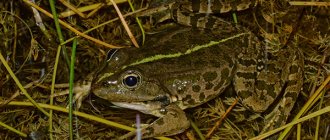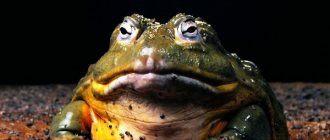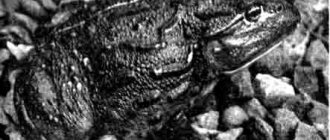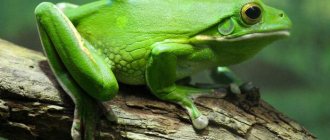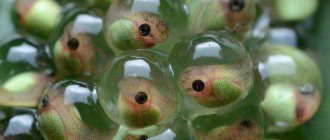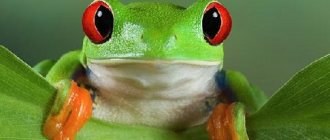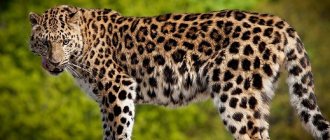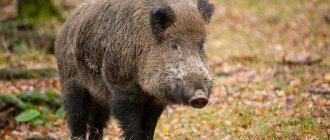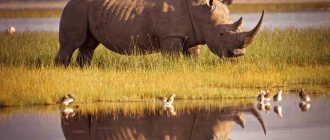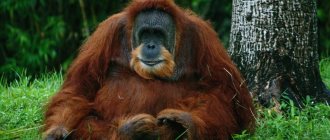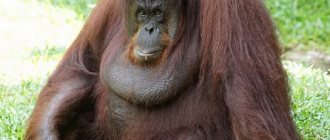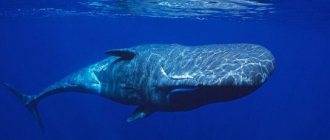Characteristics
Most often, tree frogs are brightly colored. The standard color is a green back with emerald tints, and a milky belly. Along the sides there is a stripe, which can be either black or gray-brown, or stand out as a bright spot on a plain body.
In fact, the color directly depends on what type of poison dart frog we are talking about. There are individuals with bright blue, acid yellow and even spotted bodies. Amphibians acquire colors with age. Tadpoles are born inconspicuously brown. Color may vary depending on environmental conditions. For example, if it gets colder, the tree frog's back will become darker.
The tree frog received the name “tree nymph” for its unusual slenderness and elegance. The amphibian lives in the dense crown of plants, in the shade of bushes. In any case, the tree frog lives near bodies of water. The tree nymph is a small amphibian, most often its body length is only 5–7 cm, but some representatives reach a length of 40 cm. They are considered record holders of their kind. Males are significantly smaller in size than females.
Since frogs are cold-blooded creatures, their body temperature directly depends on environmental conditions. As soon as the air temperature drops to a critical level, tree frogs burrow underground and enter a kind of hibernation, or a state of suspended animation. Some representatives of tree nymphs are capable of spending 7 years without water, burying themselves in the desert sands. These include the Australian frog.
Description and features
When we imagine prehistoric animals, we most often picture in our imagination five-meter mammoths or terrifying dinosaurs, that is, those creatures that can only be seen in pictures. However, the ancient representatives of the fauna should also include creatures that we have known since childhood.
These are tailless amphibians, preserved to this day in the form of the most common frogs and toads. Their ancient analogues in some cases could grow up to half a meter in length. For example, the frog, now nicknamed the devil's frog, weighed about 5 kg, and, moreover, it is believed that it was famous for its aggressiveness and excellent appetite, being a dangerous predator.
The number of modern species of tailless amphibians numbers in the thousands. And their members are very interesting creatures, if only because they are able to breathe not only through the mouth and lungs, but also through the skin. But the hero of our story is a tree frog , which, unlike most of the mentioned relatives who prefer terrestrial living conditions, lives in trees.
It is related not only to frogs, which are generally considered to be real, but also to amphibian poison dart frogs - very poisonous creatures. Some of them belong to the group of especially dangerous ones, because even a small drop of the substance from their skin is enough to kill two dozen people.
But the poison of the tree frog is almost harmless, because even the most toxic species, for example, the Cuban or toad frog, secrete only enzymes that can cause an unpleasant burning sensation or irritation of the delicate tissues of the eyes and mouth. And after touching their skin, you need to wash your hands, and that’s all.
Similar amphibians form a whole family: tree frogs. And it is not by chance that its representatives were given such a name. Indeed, unlike ordinary frogs, in which only male frogs croak in the hope of attracting the attention of silent girlfriends, tree frogs and “ladies” are also vocal.
Moreover, some species do not even croak, but meow, bark, whistle or bleat. Some tree frogs make sounds similar to bird trills, for example, they sound like a nightingale. There are species whose voice is similar to metal blows or the creaking of a knife on glass. Male tree frogs are visually distinguished by a very noticeable pouch-like skin bubble on the throat; it helps the owners to enhance the calling mating sounds they produce.
The varieties representing the described family are also diverse not only in their voice, but also in their other characteristics. Looking at a photo of a tree frog , it is possible to imagine their appearance.
These creatures can be of a blurred, massive build, appear flabby, or they can look like neat little frogs or have a flattened body with bizarre, curly, as if broken limbs (this is what the red-eyed tree frog looks like). Females of most species are one and a half, or even two times larger than males.
Tree frogs are often endowed with a camouflage color by nature, primarily matching the color of lush greenery, tree bark, lichen or dried leaves among which they live. There are striped species or abounding in contrasting shades: orange, blue, red. An interesting feature of many of them is the ability to adjust their own color to the world around them.
Research has shown that such transformations are no longer generated by visual sensations, but by tactile ones. That is, signals to them are given mainly by skin receptors, and they do this not under the influence of the visible colors perceived by these amphibians, but under the influence of their general perception of the world.
Rough surfaces, being associated with earth and bark, encourage such creatures to turn gray or brown. leaves , turn the tree frog green .
The color transformations of tree frogs are related to the external environment with its changing humidity and temperature, as well as the internal moods of these creatures, the state of mind, so to speak. For example, when frozen, tree frogs most often turn pale, and when angry they can darken.
The skin of some varieties also has the ability to reflect infrared rays. This is a remarkable property that gives a chance not only not to waste heat, but also to become invulnerable to certain types of predatory creatures, for example, snakes, that perceive objects in the specified range.
Lifestyle
The tree frog is very dexterous. She moves equally quickly in water and on land. Moreover, the amphibian feels great in trees and can even jump from branch to branch. The tree frog blends in with the foliage and spends the entire day motionless, waiting for the night. It clings to the bark with the help of suction pads located at the tips of its fingers. Thanks to this device, it can stay on a smooth surface like glass or plastic without much effort.
At night, the tree frog hunts. The amphibian has excellent night vision, so not a single insect flying by goes unnoticed. However, the tree frog happily eats not only flies and mosquitoes, but also caterpillars, small bugs and ants, as well as tiny lizards. It captures prey using its long, sticky tongue. To get rid of larger food, it uses its tenacious front paws. Tree frogs, or tree frogs, are the only species of frog that can catch an insect in a jump and still stay on a branch.
These amphibians are in dire need of water, and they especially enjoy swimming. This usually happens in the evening, when twilight falls on the earth. After a whole day spent on a tree, the tree frog restores the water balance in its body by bathing, because the liquid easily passes through the amphibian’s skin.
Courtship ritual
Spawning occurs at the bottom of the reservoir. Having chosen a suitable place, the female clings to the reed stems and begins to lay eggs in small portions of 20-40 eggs. The male, holding onto the female with his front paws, picks up the next portion of eggs with his hind paws, pulls them closer to him, pours them with seminal fluid and transfers them to the female’s hind paws. The female periodically makes rotational movements around the vertical stem of the reed, gluing portions of eggs to it.
Singing
Tenacious paws with suction cups, bright colors, a long sticky tongue and excellent dexterity are the characteristics of tree frogs. How else can you determine that you are dealing with a tree frog? The clear “voice” of the amphibian will help with this. The fact is that in her throat there is a resonator with an unusual structure. At the same time, in other species of frogs it is located on the sides of the head. Thanks to this feature, the tree frog sings loudly and loudly, thereby notifying everyone around about the arrival of spring.
At those moments when amphibians sing, the skin on their neck resembles a convex ball. The sounds produced during this process are often compared to the quack of ducklings. Males are considered the best artists among representatives of this species. Their jaw skin is golden in color. Singing is also used to attract females. Representatives of each species make special sounds, so only relatives respond to the call. Mating occurs in water. First, the female lays the eggs, and then the male fertilizes them. Soon the tree frog tadpoles emerge. In 50 - 100 days they turn into adults, and after two years they reach sexual maturity.
Reproduction
Regardless of the species and lifestyle, almost all types of tree frogs are closely associated with water - especially when it comes to the breeding season.
Some of them lay eggs on the bottom of reservoirs, attaching them to stones and plants, and their tadpoles are able to attach to stones thanks to suction cups. Some of the tree frogs lay their eggs above the pond, attaching them to the foliage - and the tadpoles simply fall into the water. Sonoran tree frogs can be found in almost every puddle. Some tree frogs make nests in the axils of leaves or hollows of trees, under the bark - in fact, in any temporary reservoirs that are regularly filled with water during rainy times.
Red-eyed tree frogs
One female usually lays several portions of game (from 3 to 21) - and each of them is a lump of many eggs. Thus, one female is capable of laying almost 2000 eggs. The embryos develop for several weeks, and then they hatch into tadpoles - and they grow for up to three months. Some of the larvae survive the winter - and only then turn into small frogs.
Frogs reach sexual maturity at approximately the age of several years - up to four.
I
The tree frog can be poisonous. Therefore, sometimes bright coloring is not just a beautiful appearance, but also a warning that it is better not to mess with the amphibian. Amphibians secrete a poisonous toxin. Its victim can be paralyzed, stunned or even killed. Some representatives of amphibians are considered among the most dangerous creatures on the planet.
The American aborigines, commonly called Amerindians, have benefited from the deadly poison for many centuries. When hunting, they use darts whose tips are lubricated with a deadly substance. To collect the poison, they pierced the frog and held it over the fire for some time. The drops that appeared on her skin were collected in a separate container. Arrowheads were dropped there. Because of this, representatives of tree frogs began to be called dart frogs.
Varieties
There are at least 175 varieties of brightly colored tree frogs. However, only 3 of them pose a mortal danger to humans. Other amphibians are not poisonous; with the help of their distinctive color they protect themselves from predators. Those tree nymphs that can actually cause death prefer solitude; they gather in groups only during the mating season, when they reach the age of 2 years. They attack large animals only if they sense danger. They strive to protect their home.
Enemies
The main danger to the tree frog is snakes (parrot, cat-eyed, etc.), as well as lizards, birds, bats and small mammals. Eggs are eaten by monkeys, wasps, reptiles, etc.
They suffer from fungal infections. Fish, arachnids, and arthropods can destroy tadpole fry.
Yellow poison dart frog
The habitat of this amphibian is the tropical rainforests of Colombia, located in its southwest. For rest, the amphibian chooses leaf litter under the dense crowns of trees growing near the reservoir. The terrible leaf climber, as it is also called, is considered the most dangerous vertebrate in the world. The venom of this undoubtedly beautiful tree frog is capable of taking the lives of 10 people at a time. The frog has powerful hind legs. The body is painted yellow-gold with black splashes on the head and body.
Links[edit]
- ^ abc IUCN Amphibian Specialist Group. (2015). Lithobates sylvaticus
. IUCN Red List of Threatened Species doi: 10.2305/IUCN.UK.2015-4.RLTS.T58728A78907321.en. - Yuan, Z.-Y.; and others. (2016). "Spatiotemporal diversification of true frogs (genus Rana): a historical basis for a widely studied group of model organisms". Systematic biology
.
65
(5):824–42. DOI: 10.1093/sysbio/syw055. PMID 27288482. - ↑
Mahoney, Bill (June 17, 2015).
"Senate Supports Tree Frog—Barely". Capital New York
. Retrieved June 18, 2015. - Monnet JM; Cherry M.I. (2002). "Sexual size dimorphism of anurans". Proceedings of the Royal Society
B.
269
(1507):2301–2307. DOI: 10.1098/rspb.2002.2170. PMC 1691160. PMID 12495496. - ^ a b c d e Howard RD (1980). "Mating behavior and mating success in tree frogs, Rana sylvatica
."
Animal behavior
.
28
(3):705–716. DOI: 10.1016/S0003-3472 (80) 80130-8. S2CID 53167679. - Conant R, Collins JT. (1998). A Field Guide to Reptiles and Amphibians: Eastern and Central North America.
Third edition. New York (NY): Houghton Mifflin Company ISBN 0395904528. - Conant, Roger. (1958). A Field Guide to Reptiles and Amphibians. Houghton Mifflin Company, Boston.
- Wilbur H. M. (1977). "Interaction of food level and population density in Rana sylvatica
".
Ecology
.
58
(1):206–209. DOI: 10.2307/1935124. JSTOR 1935124. - Redmer, Michael & Trout, Stanley E. (2005). Declining Amphibians: Conservation Status of Species in the United States
M. Lannu, ed. University of California Press ISBN 0520235924. - ^ab Cardini, F. (1974). Specializations of the feeding response of the bullfrog, Rana catesbeiana
, to capture submerged prey. Doctoral dissertation, University of Massachusetts, Amherst, Massachusetts. - Cardini, F. (1973). Characteristics and adaptability of the feeding behavior of North American anurans, paper presented at the June 1973 meetings of the Animal Behavior Society, Amherst, Massachusetts.
- Story KB; Storey JM (1984). "Biochemical adaptation to frost tolerance in the tree frog Rana sylvatica
".
Journal of Comparative Physiology
B.
155
: 29–36. DOI: 10.1007/BF00688788. S2CID 29760226. - Wilbur H. M. (1997). "Experimental food web ecology: complex systems in temporary reservoirs." Ecology
.
78
(8):2279–2302. doi:10.1890/0012-9658(1997)078[2279:EEOFWC]2.0.CO; 2. - Kenneth B. Story (1997). "Organic solutes in frost resistance." Comparative Biochemistry and Physiology
.
117
(3):319–326. DOI: 10.1016/s0300-9629(96)00270-8. PMID 9172388. - Costanzo JP; Lee RE Jr; DeVries AL; Wang T; Lane Jr. (1995). "Mechanisms of survival of vertebrate ectotherms at subzero temperatures: applications in cryomedicine". FASEB Magazine
.
9
(5): 351–358. DOI: 10.1096/fasebj.9.5.7896003. PMID 7896003. S2CID 13484261. - Daudet, L; Van Baelen, K; Wuytack, F; Dean, W. L. (2001). "Low-temperature molecular adaptation of sarco(endo)plasmic reticulum skeletal muscle Ca2+-ATPase 1 (SERCA 1) in the tree frog (Rana sylvatica)". Journal of Biological Chemistry
.
276
(6):3911–9. DOI: 10.1074/jbc.m007719200. PMID 11044449. - ^ a b c d e Berven K.A. (1981). "Selection of a mate of the wood frog, Rana sylvatica
."
Evolution
.
35
(4):707–722. DOI: 10.2307/2408242. JSTOR 2408242. PMID 28563133. - Seale D. B. (1982). "Physical factors influencing oviposition by the wood frog, Rana sylvatica
, in Pennsylvania."
Kopeya
.
1982
(3):627–635. DOI: 10.2307/1444663. JSTOR 1444663. - ^ a b c d Berven K.A.; Grudzen T.A. (1990). "Dispersal in the tree frog ( Rana sylvatica
): implications for genetic population structure".
Evolution
.
44
(8):2047–2056. DOI: 10.2307/2409614. JSTOR 2409614. PMID 28564421. - ^ abc Herreid CF II; Kinney, S. (1967). "Temperature and development of the tree frog Rana sylvatica
in Alaska."
Ecology
.
48
(4):579–590. DOI: 10.2307/1936502. JSTOR 1936502. - Berven K. (1990). "Factors influencing fluctuations in abundance of larval and adult wood frogs ( Rana sylvatica
)".
Ecology
.
71
(4):1599–1608. DOI: 10.2307/1938295. JSTOR 1938295. - Berven K. (1988). "Factors influencing variation in reproductive traits in a population of tree frogs ( Rana sylvatica
)".
Kopeya
.
1988
(3):605–615. DOI: 10.2307/1445378. JSTOR 1445378. - Sanzo, Domenico; Heknar, Stephen J. (03/01/2006). "Effects of road de-icing salt (NaCl) on tree frog (Rana sylvatica) larvae." Environmental pollution
.
140
(2):247–256. DOI: 10.1016/j.envpol.2005.07.013. ISSN 0269-7491. PMID 16159689.
Red frog
This family of frogs, like poisonous leaf climbers, is an example of how beauty and death can combine. Another of its representatives is the red poison frog, which was first described only in 2011. It lives in the jungles of Nicaragua, Panama and Costa Rica. The body, which is 1.5 cm long, is colored in a red-orange or strawberry palette. The hind legs are bright blue, and there are black markings on the head and back. The tree frog is the second most dangerous creature in the world after the yellow poison frog.
Blue poison frog - okopipi
Scientists first discovered this deadly creature in the Amazon rainforest in 1968. The amphibian has an amazing color: bright sky blue cobalt combined with azure sapphire hue. There are black and white patches throughout the body. This is a classic tree frog color scheme.
Local aborigines, however, have been familiar with the amphibian for a long time. According to one version, due to the fact that during the Ice Age, part of the jungle was only a grassy plain, representatives of the poisonous tree frog were “preserved.” An interesting fact is that the okopipi is an amphibian that obtains the necessary moisture in the rainforest forests, so it does not even know how to swim.
Behavior
The Australian white tree frog leads a crepuscular lifestyle. In case of danger, it hides and, using its protective coloring, remains motionless until the last limit, and then jumps onto a previously chosen branch. In September-October it goes into hibernation. Highly adaptable, so it can settle in agricultural areas. It waits out the dry season in deep, damp burrows, forming a cocoon of epidermis and mucus around itself.
Phyllomedusa
Some tree frogs, photos of which are presented in this article, as mentioned earlier, are poisonous. These include the phyllomedusa, whose venom affects the nervous and digestive systems. For example, it can cause gastrointestinal upset as well as hallucinations. Phyllomedusa is considered one of the largest tree frogs in the world. The body length of the male is about 9 – 10 cm. The female is slightly larger: 11 – 12 cm.
Its natural habitat is the Amazon and northern Bolivia. These representatives of amphibians are found in Brazil, in eastern Peru, in the southern regions of Colombia, and also in Guyana. These frogs are most common in savannas and forests. They can be kept at home. In this case, their body will acquire a bright color in two months. In six months to 10 months, the individual will reach sexual maturity and will be ready to reproduce.
Population/conservation status
Currently, the population size of the species is gradually declining. Threats to the species: loss and degradation of habitat (water pollution, deforestation, construction of hydraulic structures). Currently, there are 6-8 subspecies, of which 3 are found within our country. A poison is secreted on the skin - a peptide that is not dangerous to humans. After contact with a frog, it is advisable to wash your hands.
The common tree frog is listed in the IUCN Red List as a species with a low risk of extinction.
Literature: 1. I.P. Sosnovsky. Amphibians and reptiles of the forest, Timber industry, 1983 2. Key to amphibians and reptiles of the fauna of the USSR. Moscow, “Enlightenment”, 1977 3. Altmann Khorog. Poisonous plants. Poisonous animals/Translated by him. - M.: 4. Ya. I. Garanin, Amphibians and reptiles of the Volga-Kama region, Publishing House "Nauka", 1983 5. Translation from English www.zooclub.ru 6. Amphibians of Ukraine. Evgeny Pisanets, Kyiv, 2007 7. Essays on biology. A.G. Bannikov, M.N. Denisova. Moscow, 1956 8. Plants and animals. K. Nidon, Dr. I. Peterman, P. Scheffel, B. Shayba Translation from German by N.V. Khmelevskaya, Moscow “Mir”, 1991
Bright-eyed tree frog
This genus includes representatives of 8 species of tree frogs, among which is the red-eyed tree frog. The length of its body does not exceed 7.5 cm. Due to the fact that the main color is green, the tree frog can easily camouflage itself among dense foliage. The base of the paws, as well as the sides, are colored neon blue. It has a yellow pattern on it. Fingers are orange. This coloring makes representatives of the red-eyed frogs the most striking of their kind. The bright color is recognizable even by predatory organisms that are colorblind by nature. In nature, this tree frog prefers to climb higher, to the middle or upper tiers of trees.
The tree frog got its name due to its amazing red eyes with a vertical pupil. They are disproportionately large compared to the entire body, so in the dark the illusion of a large animal is created. This deters many predators. Like other representatives of this species, it hunts insects and sometimes catches small lizards and arachnids. It breeds almost all year round. This is due to the fact that the red-eyed frog lives in tropical forests. The tree frog protects itself by its bright appearance, so it is not poisonous.
Appearance
In appearance, the common tree frog is similar to a small frog, with long and thin legs. It climbs well on smooth vertical surfaces, jumps and swims well. The eyes are large and expressive. The ends of the tree frog's fingers are widened, with suction discs. There are membranes between the toes of the hind limbs. The skin on the back is smooth, on the ventral side it is coarse-grained. Sexual dimorphism is weakly expressed: males have a large resonator on the throat, nuptial calluses on the first toe of the forelimbs.
